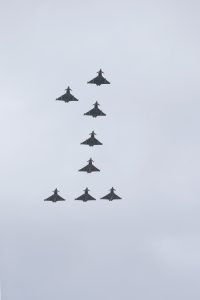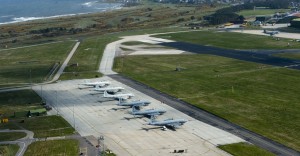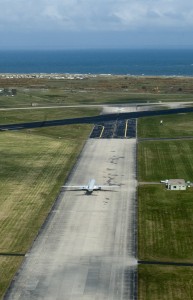2017-07-12 By Robbin Laird
During my visit to RAF Lossiemouth in March 2017, I had a chance to talk with the senior officers involved in rebuilding the infrastructure at the base for the arrival of an additional Typhoon squadron and for the coming of the P-8.
Having visited Norway earlier this year and having discussed among other things, the coming of the P-8 and the F-35 in Norway, it is clear that what happens on the other side of the North Sea (i.e., the UK) is of keen interest to Norway. And talking with the RAF and Royal Navy, the changes in Norway are also part of broader UK considerations when it comes to the reshaping of NATO defense capabilities in a dynamic region.
In effect, the changes on the UK side of the North Sea are experiencing the standup of a P-8 base at Lossie, which will integrate with US P-8 operations from Iceland and with those of Norway as well.
In effect, a Maritime Domain Awareness highway or belt is being constructed from the UK through to Norway.
A key challenge will be establishing ways to share data and enable rapid decision-making in a region where the Russians are modernizing forces and expanded reach into the Arctic.
What was clear from discussions at Lossie is that the infrastructure is being built from the ground up with broader considerations in mind, which I am calling, building a 21st century MDA highway.
To the South, at Marham and Lakenheath, the UK and the US are shaping would clearly be an integrated operational capability reaching to Norway, Denmark and the Netherlands.
Flying the same ISR/C2/strike aircraft, the challenge will be similar to what will be seen in crafting the MDA highway as well – how best to share combat data in a fluid situation demanding timely and effective decision-making?
The UK is clearly a key player in shaping the way ahead on both, investing in platforms, infrastructure and training a new generation of operators and maintainers as well.
 Typhoon aircraft relocate to RAF Lossiemouth Number 1 (Fighter) Squadron marks relocation with a special 8-ship formation in the shape of a number 1. Credit: RAF, 2014
Typhoon aircraft relocate to RAF Lossiemouth Number 1 (Fighter) Squadron marks relocation with a special 8-ship formation in the shape of a number 1. Credit: RAF, 2014
But the big rebuilding project involves P-8s and shaping the main operating base for the aircraft at Lossie.
During the discussion, Squadron Leader McDonald went to the walls of her office and began pointing at her various and diverse base maps to explain how the base was being reconfigured.
The big change on the way is building a new P-8 facility outside of the existing operating base.
This was challenge in part because of the need to dig deep and to secure the hangers and other facilities.
Lossie is facing the North Sea, so getting to bedrock is not easy.
The location though of the base is excellent from an operational point of view as Wing Commander Allen explained: “The transit time to the area of interest is much better from Lossie as opposed to say Waddington.
“We are talking approximately 1 and ½ hour’s savings of time to the areas of interest.
“That is significant in terms of giving us an operational advantage.”
The first challenge is constructing new facilities for the new Typhoon squadron.
“We compared the option of simply refurbishing old Tornado facilitates or building new ones.
“It makes more sense to build new ones given the age and condition of the legacy buildings.
“So we are building the new site on the location of a Tornado engineering facility.
“The new building will provide better support to Typhoon.”
The second challenge is building the P-8 facility with its very large hangers and support facilities.
The RAF is getting two hangars for the P-8 and Boeing is building one for servicing UK and other P-8 aircraft in the region.
According to Wing Commander Allen, “the hangars will be very large and be able to hold three P-8s at a time.
“The size of the hangar is 265 meters by 100 meters and will stand four stories up.
“The hangers will house the support capabilities, such as the training center.
“Behind the main operating hangars will be the engineering support facility.”
 Operation Joint Warrior. Credit:RAF, 4/30/12
Operation Joint Warrior. Credit:RAF, 4/30/12
Boeing is investing in the base as well.
According to a 2016 BBC story: “Boeing has confirmed it will invest about £100m in an operational support and training base at RAF Lossiemouth, creating more than 100 new jobs.
The move is part of a deal struck between Boeing and the UK government.”
http://www.bbc.com/news/uk-scotland-scotland-business-36763883
In addition to housing for the UK needs, the US Navy will operate there as well and the Norwegians will train at the base.
And according to Wing Commander Allen, they are looking to other P-8s users to come to the base as well, notably the Australians.
Allen commented with regard to the Norwegians:
“We have talked about sharing of facilities with Norway because they were getting P-8 and we’re looking at the same piece of water.
“Its just a question of working out how we can share facilities in an effective manner going forward.”
When one flies into Aberdeen, it is hard to miss the significant Norwegian presence in the North Sea oil business.
In effect, the commercial side of the house has preceded what one might well see on the military side.
The twin transformation – a major one for P-8 and an upgrade for Typhoon – means that other facilities will be modernized as well.
In addition to runway servicing, a new control tower will be built on a new location on the base. The location selected provides a better view of the overall operating base emerging at Lossie compared the legacy air tower.
Collocated with the new air control tower will be a new fire station to handle emergencies.
As Squadron Leader Macdonald noted: “We also need an upgraded fire station too because the Crash CAT will rise up to Crash CAT seven for P-8 – because of the crew numbers on the aircraft.”
 Operation Joint Warrior, Credit: RAF, 4/30/12
Operation Joint Warrior, Credit: RAF, 4/30/12
And Wing Commander Allen highlighted a core 21st century aspect of infrastructure:
“The challenge is how will we handle the huge amount of data being generated by our P-8 force let alone by the other P-8s operating in the area?
“How to identify rapidly what is most relevant to whom in the operational space?”
And that leads as well to another infrastructure challenge – power supplies and information and communication cabling.
This is not the most visible or sexy part of an infrastructure discussion but it is central to a 21st century base, notably as information rich aircraft are added to the fleet.
The challenge will be to deal with the old and the new when sorting through a cabling and power architecture that can support a 21st century fleet.
When I visited Marham, much of the base had been ripped up precisely to deal with the twin challenges of power supply and information infrastructure.
And as at Marham, there is significant time pressure.
The delivery of the aircraft is one timeline; the preparation of the base to support P-8s is another.
And obviously you want the time deltas to converge effectively.
This is a challenge which I am sure will keep these two officers more than busy.

